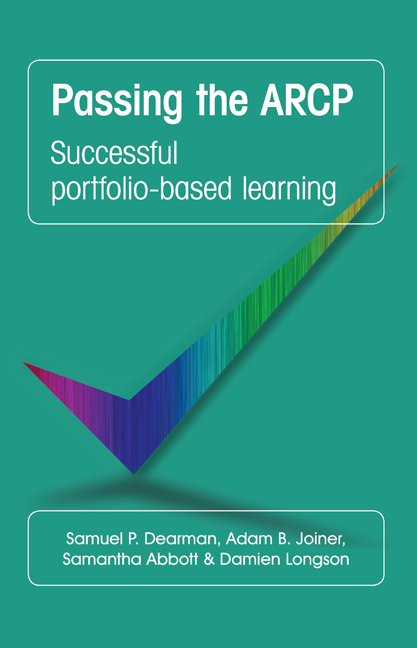Book contents
- Frontmatter
- Contents
- Authors
- List of figures
- Foreword
- Preface
- Acknowledgements
- List of abbreviations
- How to use this guide
- 1 Quick reference guide
- 2 What is a portfolio?
- 3 Lessons learned so far
- 4 Organising the portfolio
- 5 Managing your workplace-based assessments
- 6 Reflective practice and self-appraisal of learning
- 7 Audit and research
- 8 Teaching
- 9 Psychotherapy experience
- 10 Management and leadership experience
- 11 Appraisal reports, planning meetings and educational objectives
- 12 Other experiences, achievements and documents
- 13 The future of portfolios
- Index
1 - Quick reference guide
- Frontmatter
- Contents
- Authors
- List of figures
- Foreword
- Preface
- Acknowledgements
- List of abbreviations
- How to use this guide
- 1 Quick reference guide
- 2 What is a portfolio?
- 3 Lessons learned so far
- 4 Organising the portfolio
- 5 Managing your workplace-based assessments
- 6 Reflective practice and self-appraisal of learning
- 7 Audit and research
- 8 Teaching
- 9 Psychotherapy experience
- 10 Management and leadership experience
- 11 Appraisal reports, planning meetings and educational objectives
- 12 Other experiences, achievements and documents
- 13 The future of portfolios
- Index
Summary
The portfolio
• The successful portfolio is a developmental tool that builds a collection of evidence of experience, assessments of competence, self-reflection and personal development planning over time.
• Trainees should ‘own’ the portfolio by managing their own learning, using the portfolio as an iterative tool.
• Portfolio evidence of competence must demonstrate trainees’ performance in reality rather than their factual knowledge or abilities in controlled examinations.
• Evidence of achievement of competencies occurs by combining different forms of evidence and assessments in various contexts and with multiple assessors.
• The more often the portfolio is used, the better, using formal points of appraisal as landmarks.
• True evidence in the portfolio is clear, transparent and demonstrable proof of competence.
• The evidence should not be overstretched.
• Attending a training course is not in itself evidence of competence.
• The portfolio supports the General Medical Council (GMC) revalidation process (General Medical Council, 2013).
Organising the portfolio
• Organisation and reference to clearly indexed, triangulated evidence at the start of the portfolio sets the tone.
• Make it user-friendly; summarise evidence and clearly state the competency, giving clear and specific locations of evidence.
• How much is enough evidence? Two sources at least and three where possible.
• Plan your educational objectives early with reference to competencies.
• Remember that ‘if it is not documented, it did not happen’.
• Do not breach confidentiality within the portfolio. Never use patient-identifiable material. If letters about patients are included, remove all identifiers.
• Do not leave portions of the curriculum uncovered, especially if they are hard to evidence. Consider mapping the gaps.
Workplace-based assessments (WPBAs)
• The need to evidence a particular competence should drive which WPBA is chosen, not the other way round. Workplace-based assessment should occur regularly throughout a period in training. Do an Assessment of Clinical Expertise (ACE) early on as a benchmark.
• Present WPBAs in a logical sequence with a clear description of the experience and associated competencies.
• Link WPBA to reflective practice and show how this informs your professional development.
• Capitalise on opportunities in routine work – if you are discussing a case as a part of daily work, use it as a case-based discussion (CbD) WPBA.
• Patient feedback can be a powerful driver for learning.
- Type
- Chapter
- Information
- Passing the ARCPSuccessful Portfolio-Based Learning, pp. 1 - 3Publisher: Royal College of PsychiatristsFirst published in: 2017



